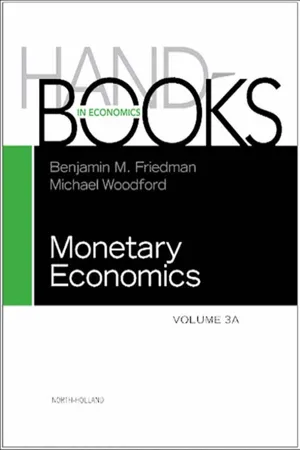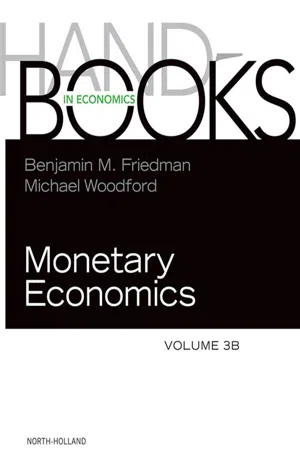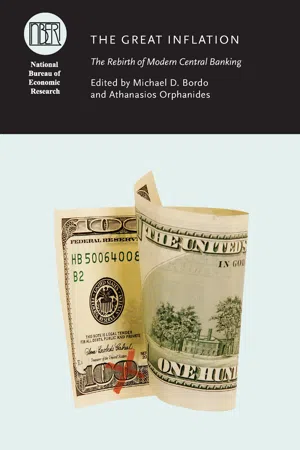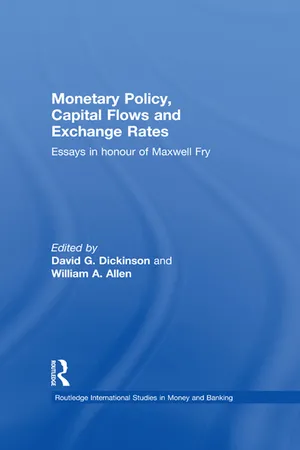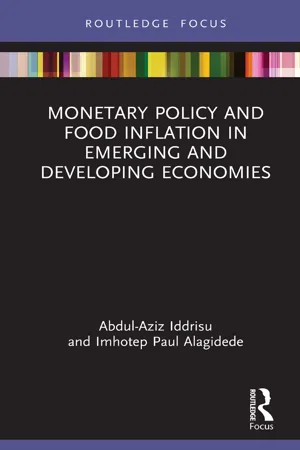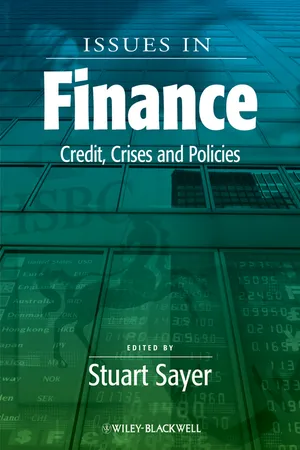Economics
Inflation Targeting in Canada
Inflation targeting in Canada refers to the monetary policy framework where the central bank sets a specific target for the inflation rate and adjusts its policy instruments to achieve that target. The Bank of Canada has employed this strategy since the early 1990s, aiming to keep inflation within a target range of 1 to 3 percent. This approach provides transparency and accountability in monetary policy decision-making.
Written by Perlego with AI-assistance
Related key terms
Related key terms
1 of 4
Related key terms
1 of 3
11 Key excerpts on "Inflation Targeting in Canada"
- eBook - ePub
- Benjamin M. Friedman, Michael Woodford(Authors)
- 2010(Publication Date)
- North Holland(Publisher)
Monetary Economics , Vol. Suppl., No. 2011ISSN: 1573-4498doi: 10.1016/B978-0-444-53454-5.00010-4Chapter 22 Inflation Targeting*Lars E.O. Svensson, Sveriges Riksbank and Stockholm UniversityAbstract AbstractInflation targeting is a monetary-policy strategy characterized by an announced numerical inflation target, an implementation of monetary policy that gives a major role to an inflation forecast that has been called forecast targeting, and a high degree of transparency and accountability. It was introduced in New Zealand in 1990, has been very successful in terms of stabilizing both inflation and the real economy, and as of 2010 has been adopted by about 25 industrialized and emerging-market economies. This chapter discusses the history, macroeconomic effects, theory, practice, and future of inflation targeting.JEL classification E52 E58 E42 E43 E47Keywords Flexible Inflation Targeting Forecast Targeting Optimal Monetary Policy Transparency1 Introduction
Inflation targeting is a monetary-policy strategy that was introduced in New Zealand in 1990. It has been very successful, and as of 2010 had been adopted by approximately 25 industrialized and nonindustrialized countries. It is characterized by (1) an announced numerical inflation target, (2) an implementation of monetary policy that gives a major role to an inflation forecast and has been called forecast targeting, and (3) a high degree of transparency and accountability (Svensson, 2008 - eBook - ePub
- Benjamin M. Friedman, Michael Woodford(Authors)
- 2010(Publication Date)
- North Holland(Publisher)
Svensson, 2008 ). Inflation targeting is highly associated with an institutional framework characterized by the trinity of (1) a mandate for price stability, (2) independence, and (3) accountability for the central bank. But there are examples of highly successful inflation targeters, such as Norges Bank, that lack formal independence (although their de facto independence may still be substantial).1.1 An announced numerical inflation target
The numerical inflation target for advanced countries typically is around 2% at an annual rate for the Consumer Price Index (CPI) or core CPI, in the form of a range, such as 1 to 3% in New Zealand; a point target with a range, such as a 2% point target with a range/tolerance interval of ± 1 percentage points in Canada; or a point target without any explicit range, such as 2% in Sweden and the UK and 2.5% in Norway. The difference between these forms does not seem to matter in practice. A central bank with a target range seems to aim for the middle of the range. The edges of the range are normally interpreted as “soft edges,” in the sense that they do not trigger discrete policy changes and inflation just outside the range is not considered much different from just inside. Numerical inflation targets for emerging markets and developing countries are typically a few percentage points higher than 2%.In practice, inflation targeting is never “strict” but always “flexible,” because all inflation–targeting central banks (“central bank” is used here as the generic name for monetary authority) not only aim at stabilizing inflation around the inflation target but also put some weight on stabilizing the real economy; for instance, implicitly or explicitly stabilizing a measure of resource utilization such as the output gap; that is, the gap between actual and potential output. Thus, the “target variables” of the central bank include inflation as well as other variables such as the output gap.1 The objectives under flexible inflation targeting seem well approximated by a standard quadratic loss function consisting of the sum of the squared inflation gap to the target and a weight times the squared output gap, and possibly also a weight times squared policy-rate change (the last part corresponds to a preference for interest-rate smoothing).2 However, for new inflation–targeting regimes, where the establishment of “credibility” is a priority, stabilizing the real economy probably has less weight than when credibility has been established (more on credibility below). Over time, when inflation targeting matures, it displays more flexibility by putting relatively more weight on stabilizing resource utilization. Inflation–targeting central banks have also become increasingly transparent about being flexible inflation targeters. Section 4.1 - eBook - ePub
National Bureau of Economic Research Conference Report
The Rebirth of Modern Central Banking
- Michael D. Bordo, Athanasios Orphanides, Michael D. Bordo, Athanasios Orphanides(Authors)
- 2013(Publication Date)
- University of Chicago Press(Publisher)
Also, the government and the Bank of Canada, earlier, in 1991, agreed commitment to “price stability” (and to “price stability” being a rate of inflation “clearly below 2 percent” as the probable eventual goal) was expunged. While the incoming minister of finance (Paul Martin) was not, at least initially, a fan of inflation targeting, he may have considered that the arrangement was too risky to drop wholesale. The obvious question he faced, especially for an economy such as Canada’s, was what to say instead of inflation targeting that would pass muster with holders of claims on Canada, whether domestic or foreign. 10 Since that time, inflation has stayed broadly consistent with the official Bank of Canada goal, currently, of low and stable inflation. The term “price stability” virtually disappeared from the bank’s lexicon in later years. Finally, in a more positive vein, note might be taken that the bank (with a sign-off from the current minister of finance) announced in November 2006, after many years of promising to undertake a review of the inflation targeting framework, began a wide-ranging program of research designed to reexamine many aspects of it. This reexamination is going to go so far as looking at the value of lowering the current 2 percent inflation target, as well as at price level targeting—something that was quite recently advocated, but not actually tried, for Japan. Lessons This discussion has contrasted two experiences with inflation reduction—the drawn out Canadian battle over the period from the early 1970s to 1987, and the shorter one from 1987 to 1992. Shorter is clearly better - William Allen, David Dickinson(Authors)
- 2002(Publication Date)
- Routledge(Publisher)
During the quarter-century since then, the rate of inflation has been reduced tenfold, from over 25 per cent to below 2.5 per cent. The fall in the rate of inflation has not been steady or continuous. There have been a number of crises, and a number of different monetary policy techniques have been used. Inflation targeting is the latest of them, adopted after the United Kingdom left the European Exchange Rate Mechanism, and it has been the longest-lasting. The procedures of inflation targeting are still evolving in the light of continuous learning through experience.Inflation targeting is based on the assumption that low inflation is the single proper objective of monetary policy. That assumption is based, in the United Kingdom, on the unhappy experience of trying to pursue other objectives with monetary policy. It is beyond the scope of this paper to justify the assumption that price stability should be the proper objective of monetary policy. Briault (1995) sets out the arguments: the public debate in the United Kingdom has become much less heated in the last few years, perhaps largely because low inflation has been accompanied during those years by strong economic growth and falling unemployment, so that there has been no sign of a conflict between low inflation, high growth and high employment.Nevertheless, there have been some complaints in the United Kingdom that the fact that the central bank is pursuing an inflation target means that it is not concerned about output and employment. This is a misconception, because the inflation target is symmetrical. It is just as serious a policy error for inflation to be below target as it is for it to be above target, and if inflation is expected to be below target, it is the Bank of England’s duty to ease monetary policy. Moreover, the Bank of England is required by law to support the Government’s economic policy, including its objectives for growth and employment, subject to the overriding objective of maintaining price stability.- Abdul-Aziz Iddrisu, Imhotep Paul Alagidede(Authors)
- 2021(Publication Date)
- Routledge(Publisher)
2 Inflation targeting framework in emerging and developing economies: Experiences and milestonesDOI: 10.4324/9781003195368-2Introduction
The inflationary episodes of the 1970s and parts of 1980s that struck a number of advanced economies prompted a transition to inflation targeting framework by these countries as monetary policy strategies such as the monetary targeting and pegged exchange rate regimes could not deliver the needed price stability (Svensson, 2011 ). Masson et al. (1997) reckon that the challenges of monetary targeting and pegged exchange rate regimes in the 1990s precipitated an exodus to inflation targeting framework by a number of advanced economies as a way to improve their inflation footprint. New Zealand was the first nation to unveil inflation targeting framework in the world in the year 1990. Other advanced countries followed, with Canada unveiling the framework in 1991, the United Kingdom in 1992, Australia in 1993 and Sweden in 1995. What the inflation targeting framework embodies and the foundations that define its successful implementation or otherwise are the subject of the succeeding sections of this chapter.The nature and pre-requisites of inflation targeting
The inflation targeting framework involves public communication of a quantitative inflation target by a central bank, to which it exercises commitment and strives to achieve in order to establish credibility and anchor inflation expectations. The framework also embodies transparency and engender accountability as monetary policy authorities regularly engage the public on decisions arrived at and the factors that informed the said decisions. Such transparency and public engagements help to shape the inflation expectations of the public in a way that engender convergence to the announced inflation target.The numerical or quantitative inflation target can be a range, a point target with or without a tolerance band (Svensson, 2011). For instance, South Africa has an inflation target range of 3%–6%; Ghana has a point target of 8% with a tolerance band of 2% (thus 8% ±- eBook - ePub
- International Monetary Fund(Author)
- 1998(Publication Date)
- INTERNATIONAL MONETARY FUND(Publisher)
Barro and Gordon (1983) show that adherence to a rule to determine current and future monetary policy will remove the inflation bias and result in lower inflation than under discretionary monetary policy. Inflation targeting can be seen as adherence to a rule.A third development is research arguing that accountability for the inflation outcome, supported by transparency and openness of the operating framework for monetary policy, can bring important credibility gains (Nolan and Schaling, 1996 ). Inflation targets can provide a transparent guide to the specific objectives of monetary policy, whose commitment and credibility can then be assessed on the basis of whether policy actions are taken to ensure that the targets are achieved.8 Transparency can be enhanced by the central bank publicly presenting the factors influencing the forecast of inflation, including the model upon which the forecasts are based or the judgments made by the central bank. In this way, the public can assess whether the forecasts are credible and whether any monetary policy action based on the forecasts is appropriate. Furthermore, by communicating to the public the forecast path of inflation that monetary policy seeks to accomplish, inflation targets serve as a coordination device in wage- and price-setting processes and in forming the public’s inflationary expectations. If the targets are credible, they may help anchor inflationary expectations and thereby lower the costs of achieving and maintaining low inflation.International Trend Toward Inflation Targeting
The adoption of inflation targeting in Australia followed a trend toward this approach in several advanced economies in recent years. New Zealand pioneered the approach by adopting inflation targets in 1990, and was followed by Canada (1991), the United Kingdom (1992), Sweden (1993), Finland (1993), Australia (1993), and Spain (1994) (see Table 5.1 ).Table 5.1 - eBook - ePub
- Sergio Rossi(Author)
- 2007(Publication Date)
- Routledge(Publisher)
5 Monetary policy strategies
Monetary policy strategies around the world are increasingly centred on attaining some targeted rate of inflation, which several academics and policy makers assimilate to price level stability when the measured inflation rate is around but below 2 per cent (owing to a number of measurement biases, as reviewed by Rossi (2001: 31–41)). As a matter of fact, targeting inflation has become a fashion. Since the Reserve Bank of New Zealand first adopted this monetary policy strategy in 1990, an increasing number of monetary authorities around the world – first in advanced economies only, later also in developing and emerging market economies – have been abandoning their monetary or exchange rate targeting strategy to follow this new fashion. As with several fashions nevertheless, targeting an inflation rate rather than an exchange rate or a growth rate of a monetary aggregate has been adopted without any fully thought-out analytical investigation of a phenomenon as complex and controversial as inflation. The same may be argued with respect to previous monetary policy strategies, as they all stem from a symptom-based perception of inflation.It is indeed both undisputed and undisputable today that ‘[e]conomists’ perceptions of inflation rest on measurements of the “general price level” and on rates of change of price indexes’ (Gale 1981: 2). In fact, as surveys of inflation theories show, neither a satisfactory nor an exact analytical definition of inflation exists as yet in the literature (see Bronfenbrenner and Holzman 1963, Laidler and Parkin 1975, Frisch 1983, Parkin 1987, McCallum 1990). This is so much so that, to date, the phenomenon of inflation has been grasped merely by considering its most evident symptom, namely the increase of the relevant consumer price index (or some core inflation index), with no analytical thought whatsoever as to its underlying cause. - eBook - ePub
- International Monetary Fund(Author)
- 1986(Publication Date)
- INTERNATIONAL MONETARY FUND(Publisher)
The final objective of … [monetary policy] is to maintain price stability. The formulation of the monetary growth target and the measures taken to achieve this target are an “intermediate” objective. It is important in this connection to pay attention to the balance of payments and the exchange rate of the Deutsche Mark as well because, in the prevailing circumstances, it is not possible to defend the value of money in the domestic economy while disregarding the special influences that may proceed from the external value of the currency. If, as hitherto, inflationary tendencies can largely be kept out of Germany, the principal condition for sound long-term economic growth and for a high level of employment will be safeguarded.The experience in Canada illustrates the difficulties of relying on a monetary targeting strategy during a period of financial innovations. Until late 1982, the Bank of Canada operated with a target for its M1 aggregate, and through 1980 it consistently announced and hit a sequence of progressively lower target ranges. Shortly after the period of monetary targeting began, however, the authorities were apparently confronted with a shift in the demand for money related to innovations in cash management accounts for businesses. This development made it difficult to judge the degree of monetary restraint implied by the target settings, and these difficulties were compounded by inflationary pressure arising from the sharp increases in oil prices. In retrospect, the degree of monetary restraint was insufficient to keep the cost-price spiral from accelerating. During 1977 and 1978, the Canadian dollar depreciated against the U.S. dollar, even with U.S. inflation on the rise, and in 1979 Canadian inflation began to escalate (see Chart 12 ).Starting in late 1980, Canadian monetary policy was tightened considerably. However, continuing financial innovations, which were induced to some extent by the high levels of inflation and interest rates in Canada, generated further instability in the relationship between M1, nominal income, and interest rates. The shift of funds out of accounts included in M1 (currency and non-interest-bearing demand deposits) resulted, after mid-1981, in a relatively sharp divergence between the growth rates of M1 and M1A (which includes interest-bearing checkable deposits and nonpersonal notice deposits). M1 velocity increased, M1A velocity declined, and the Bank of Canada was led to conclude that since neither “the process of financial innovation” nor “the response of bank customers” could be reliably predicted, “appropriate ranges for the future growth of M1 cannot be chosen with any confidence.”11 - eBook - ePub
- Philip Arestis, Malcolm Sawyer, Philip Arestis, Malcolm Sawyer(Authors)
- 2019(Publication Date)
- Palgrave Macmillan(Publisher)
(2018) focus more strongly on the different effects between developed and less-developed economies. The fiscal stance in terms of debt to GDP ratios improves in all targeters, although as mentioned above, developing economies with high debt to GDP ratios have no incentive to introduce inflation targeting. The results are again dispersed in regard to exchange rate volatility. Developed economies face an increase in exchange rate volatility, while the situation improves in developing economies. Aizenman et al. (2011) come to similar results when focusing on less developed inflation targeters only. Summing up, it can be stated that besides of the mixed picture on the success in empirical studies, case studies suggest that inflation targeting as a monetary scheme even if it is not a framework that can be implemented in similar modes but requests a national specific modelling, holds what it promises and the theoretical background of inflation targeting per se is not questioned. Furthermore, the global financial meltdown shed light on the structural deficits of the system of inflation targeting, which led to the demand for reshaping the structure even within the orthodox thinking. Two major conclusions are drawn from a mainstream perspective after the financial crisis (Reichlin and Baldwin 2013): Inflation targeting is an adequate monetary structure to ensure price stability and enables economic development that needed a revision after the crisis—“fix it don’t scrap it” (p. 28). The macroeconomic environment after the global crisis request a stronger focus on credibility to determine expectations to cope with a more fragile banking sector and heavily indebted national states. Consequently, numerous proposals for revision were brought forward, which aim to maintain the core setting of the model within the New Synthesis framework, but adapt it to the changed environment after the financial crisis - eBook - ePub
Issues in Finance
Credit, Crises and Policies
- Stuart Sayer(Author)
- 2011(Publication Date)
- Wiley-Blackwell(Publisher)
Central banks under IT have communicated their forecasts in terms of inflation rates. Inflation expectations in countries with inflation-targeting central banks have coalesced around their targeted inflation rate. This would seem to suggest that IT has achieved a large measure of credibility in the eyes of the public where it is the official policy. If monetary policy announcements continued to be explained in terms of inflation, this would entail frequent revisions of targeted inflation rates in response to shocks that provoked deviations of the price level from its targeted path. This could lead to inflation expectations being less firmly anchored than under current IT regimes, even in the long run. It would be possible to base communication concerning monetary policy on the price level itself, rather than the inflation rate. It is possible to imagine a situation in which an interest rate increase could be justified on the basis of the percentage deviation of the targeted price index from its targeted price path. It is not known what the effects of this would be on the expectations of a public that has been conditioned for a long time to think in terms of inflation rather than the level of prices.In so far as some degree of price-level drift in response to shocks is judged to be optimal (for example, because of the presence of rule-of-thumb price-setters), the central bank's problem of how to communicate its policy becomes potentially even more complicated. One possible way to simplify communication and to ease the costs of transition would be to target average inflation. As shown in Section 4.4, the amount of price-level drift in response to exogenous shocks can be varied by assigning an average inflation objective to the central bank. Choosing the appropriate size of moving average could necessitate very little revision in the way the central bank communicates its policy decisions. All that would be required would be to redefine the targeted rate of inflation. Central banks that currently have explicit inflation targets are already implicitly using average inflation targeting. For example, the Bank of Canada tracks monthly data on the year-over-year rate of inflation, which is just the average of the 12 monthly inflation rates over the preceding year. Moving from a 12-month average to an average defined using a different window size would likely entail minimal adjustment and learning by the public.5.6 Time InconsistencyIn order for PT to be successful, both rational expectations and a credible precommitment to its future policies on the part of the central bank are crucial. However, this commitment is bound up with a fundamental time inconsistency problem. In response to a positive inflation shock, a commitment to fighting future inflation lowers the cost of fighting current inflation because of the effects of the announcement of future policy on expectations. After the central bank reaps the benefits of this announcement, it is in its interests and the interests of society as a whole to renege on its announced policies. Bringing inflation below its long-run target rate in order to return the price level to its preannounced path is costly. - eBook - ePub
Central Bank Policy
Theory and Practice
- Perry Warjiyo, Solikin M. Juhro(Authors)
- 2019(Publication Date)
- Emerald Publishing Limited(Publisher)
First , forward-looking policy while paying due consideration to the time lag of monetary policy (Svensson, 1997a). In this respect, Svensson submitted a proposal on implementing monetary policy based on inflation forecasts rather than actual values. The advantage of this theoretical approach, in addition to producing a response equivalent to optimal conditions, is to increase monetary policy credibility by focusing on inflation expectations.Second , informational requirements in policy formulation while paying due consideration to the short-term behavioral adjustment mechanism (Blake, 2000). In this regard, central banks were urged to adopt more generic policy rules, considering the factors used to make the forecasts. With the possibility of using a more detailed model specification, per Blake, model representation with an error correction mechanism could produce the best policy control framework. In the study, Blake et al. (1998) showed that a simple rule, for instance the Taylor rule, is inferior to other, more optimal and more complex rules, estimated paying due consideration to deviation from the simple rule in the event of an economic shock.The fundamental issue is how to implement an explicit monetary policy target in the utilization of instruments and choice of policy response. This is linked to the empirical condition that the actual economic behavior observed may appear consistent with the behavior of policymakers, based on optimizing the simple or relatively more complex policy response. With the conditions outlined above, studies into how monetary policy should be applied optimally in a realistic economic modeling framework, congruent with the economic characteristics or fluctuations, are a strategic choice.From the perspective of monetary policy directed toward inflation targeting, where the principles of policy transparency and credibility are imperative, the selection of rule-based policy is considered more relevant than discretion-based policy (Hubbard, 2002; McCallum, 2000). To that end, an alternative approach to study the application of optimal monetary policy is to look at alternative ways to determine the optimal monetary policy rule, namely by considering the aforementioned elements and forward-looking policy procedures.
Index pages curate the most relevant extracts from our library of academic textbooks. They’ve been created using an in-house natural language model (NLM), each adding context and meaning to key research topics.
Explore more topic indexes
Explore more topic indexes
1 of 6
Explore more topic indexes
1 of 4
